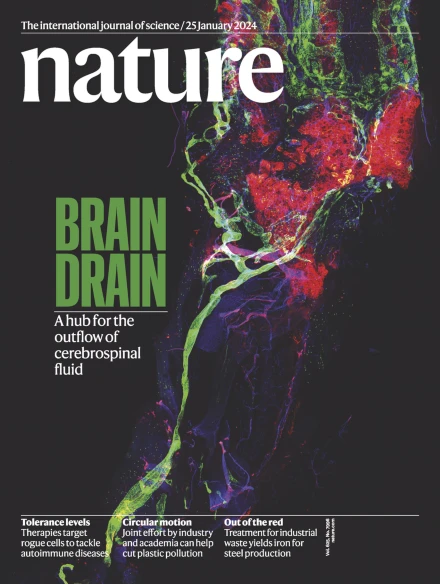Increased CSF drainage by non-invasive manipulation of cervical lymphatics
IF 48.5
1区 综合性期刊
Q1 MULTIDISCIPLINARY SCIENCES
引用次数: 0
Abstract
Cerebrospinal fluid (CSF) in the subarachnoid space around the brain drains to lymph nodes in the neck, but the connections and regulation have been challenging to identify1–24. Here we used fluorescent tracers in Prox1–GFP lymphatic reporter mice to map the pathway of CSF outflow through lymphatics to superficial cervical lymph nodes. CSF entered initial lymphatics in the meninges at the skull base and continued through extracranial periorbital, olfactory, nasopharyngeal and hard palate lymphatics, and then through smooth muscle-covered superficial cervical lymphatics to submandibular lymph nodes. Tracer studies in adult mice revealed that a substantial amount of total CSF outflow to the neck drained to superficial cervical lymph nodes. However, aged mice had fewer lymphatics in the nasal mucosa and hard palate and reduced CSF outflow to cervical lymph nodes. Superficial cervical lymphatics in aged mice had increased endothelial cell expression of Nos3, encoding endothelial nitric oxide synthase (eNOS), but had less eNOS protein and impaired nitric oxide signalling. Manipulation of superficial cervical lymphatics through intact skin by a force-regulated mechanical device doubled CSF outflow and corrected drainage impairment in aged mice. This manipulation increased CSF outflow by compressing superficial cervical lymphatics while having little effect on their normal spontaneous contractions. Overall, the findings highlight the importance of superficial cervical lymphatics for CSF outflow and the potential for reversing CSF drainage impairment by non-invasive mechanical stimulation. The outflow pathway of cerebrospinal fluid into lymph nodes in the neck and how non-invasive mechanical stimulation can enhance drainage and restore impaired outflow in aged mice are explored.


通过无创操作颈淋巴增加脑脊液引流
脑脊液(CSF)在脑周围的蛛网膜下腔中流向颈部淋巴结,但其连接和调节一直具有挑战性,难以确定1、2、3、4、5、6、7、8、9、10、11、12、13、14、15、16、17、18、19、20、21、22、23、24。我们在Prox1-GFP淋巴报告小鼠中使用荧光示踪剂来绘制脑脊液流出经淋巴到颈部浅表淋巴结的途径。脑脊液进入颅底脑膜的初始淋巴管,经颅外眶周淋巴管、嗅淋巴管、鼻咽淋巴管和硬腭淋巴管,再经平滑肌覆盖的颈浅淋巴管至下颌下淋巴结。在成年小鼠中进行的示踪研究显示,大量的脑脊液流出到颈部,流向颈部浅表淋巴结。然而,老年小鼠鼻黏膜和硬腭的淋巴管减少,脑脊液向颈部淋巴结的流出量减少。老年小鼠颈部淋巴细胞表面编码内皮型一氧化氮合酶(eNOS)的内皮细胞Nos3表达增加,但eNOS蛋白表达减少,一氧化氮信号传导受损。用力调节机械装置通过完整皮肤操纵颈部浅表淋巴,使老年小鼠脑脊液流出量增加一倍,并纠正了引流损伤。这种手法通过压迫颈浅淋巴增加脑脊液流出,而对其正常的自发收缩几乎没有影响。总的来说,研究结果强调了颈浅淋巴对脑脊液流出的重要性,以及通过非侵入性机械刺激逆转脑脊液引流障碍的潜力。
本文章由计算机程序翻译,如有差异,请以英文原文为准。
求助全文
约1分钟内获得全文
求助全文
来源期刊

Nature
综合性期刊-综合性期刊
CiteScore
90.00
自引率
1.20%
发文量
3652
审稿时长
3 months
期刊介绍:
Nature is a prestigious international journal that publishes peer-reviewed research in various scientific and technological fields. The selection of articles is based on criteria such as originality, importance, interdisciplinary relevance, timeliness, accessibility, elegance, and surprising conclusions. In addition to showcasing significant scientific advances, Nature delivers rapid, authoritative, insightful news, and interpretation of current and upcoming trends impacting science, scientists, and the broader public. The journal serves a dual purpose: firstly, to promptly share noteworthy scientific advances and foster discussions among scientists, and secondly, to ensure the swift dissemination of scientific results globally, emphasizing their significance for knowledge, culture, and daily life.
 求助内容:
求助内容: 应助结果提醒方式:
应助结果提醒方式:


